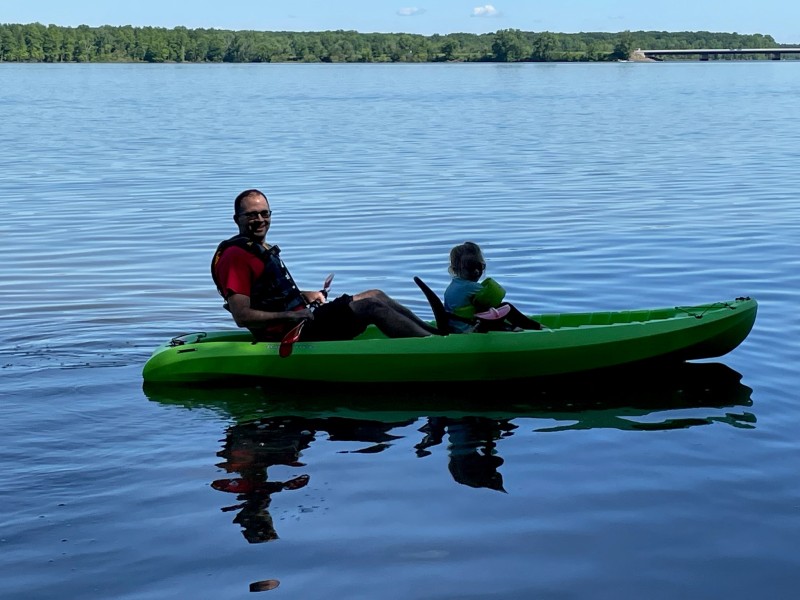Rowboat > Bus for Assessing an Organization
by Dan Hampu, Burton D. Morgan Foundation President & CEO

In "Good to Great," Jim Collins compared an organization to a bus. Simply put, he stated that it is most important to get the right people on the bus, then get them in the right seats on the bus, and then decide where to go. I used to really like this concept until this past summer when I spent quiet time kayaking with my beautiful daughter.
On that hot summer day, my little girl picked up the oar. It started with just that: picking up the oar. She then asked where we were going. I asked her where she wanted to go. Once we agreed on where, we started to row. She wanted to row to help us get there but needed some help. After meandering around, we eventually made it to our goal, which was the other side of the lake where there were some pretty water lilies. We picked some to take back to momma. I was amazed at how being in the boat, with oars in hand, a clear destination, a solid why, a clear understanding of roles, and some coaching and encouragement (both ways) that a little girl and her dad could do something pretty remarkable.
That's when it hit me.
JIM COLLINS IS WRONG. His bus should be a rowboat. Here's why:
The oar. Being in a seat on a bus is passive. Although you can go to work in an organization and sit all day doing little to nothing, that is not ideal. Being in a seat on a rowboat with an oar is active. You have the power to impact the rowboat's course toward its destination. This is EXTREMELY powerful for many reasons.
Organizations and their leaders set these destinations in the form of north stars, mission statements, culture, and goals. When you are seated in a rowboat, you can choose to do one or a combination of many things, including jump off, which is an option. Each of these actions have impacts on the rowboat (organization).
- Row backwards. Progress toward the destination is slowed. Depending on the strength of the rower and the number of rowers rowing backwards, the boat could go backwards, slow down, be taken off course, or all the above. If you work in a startup, you really feel this. If you work in a big company, it is still felt but may not be as noticeable on an organizational level. Either way, this is not good.
- Drag oar in the water. Anyone that has rowed in a kayak or a rowboat of any variety knows that if you drop an oar off the side and hold on, the boat slows and starts to turn. Others have to work harder to keep the boat on course. Again, if you work in a startup, this is really noticeable. If you work in a big organization, it is less noticeable. This is also not good.
- Not row. This is NOT ideal but I do not think it is the worst case scenario. Others in the organization have to carry your weight. Team members may be frustrated because they see you with an oar that is not being used. Again, in a startup when you are all working in the same room, this is really noticeable in actions and results. It's frustrating. This may be less noticeable as a big organization but clear in your group/division.
- Throw/drop your oar overboard. At least you aren't rowing against the progress of the organization but you are not helping. You either intentionally threw your oar overboard (really bad unless trying to defend against something) or you were not diligent with your care of the oar. Others are still having to carry your weight with each row of their own. Morale might decrease and others might be prone to join you in throwing oars overboard.
- Jump off. You see something you want to jump in the water after (new idea), you are fed up with being in the boat or rowing, or you just want to cool down on a hot day (maybe a vacation). This is NOT ideal for the rowboat in its pursuit of the north star, mission, and goals but it is understood for whatever the reason.
- OUT of sync rowing. You are trying. You either think you are doing the right things in the right way and aren't or you do not know where we are rowing and how we should be rowing. This is often a result of poor clarity and communication from the leader(s) of the boat.
- IN sync rowing. Magic. Organizations have clearly identified north stars, missions, goals, and culture. These are clearly communicated to the rowers and everyone is rowing in sync, with full force and passion towards the destination. I envision the Olympic crew teams when I think of this. The fastest of which can reach upwards of 14 mph while the fastest individual swimmers can reach 5 mph. What a difference.
I'm sure you've experienced professional and personal situations that fit all seven of the above rowing examples. If you previously didn't think about them in this context before, I hope this is a playful way to identify where your organization may be, where divisions or groups are, and what each team member is doing.
Earl Nightingale said, "[w]ithout a goal we are much like the man with a boat and nowhere to go. Goals give us the drive and energy we need to remain on track long enough for their accomplishment."
Maybe in the future I will embark on how the motor, GPS, and other technologies relate to AI and the impact on the workforce.
Anchors away!
Disclaimer: Jim Collins is an awesome author. I have loved each book of his that I have read. If you haven't read his stuff, get your hands on a copy and read it. You won't be disappointed.

